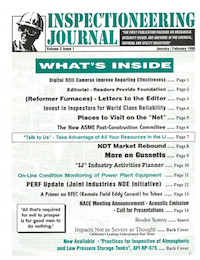 Over 20 years ago, in the January/February 1996 issue of Inspectioneering Journal, we invited readers to participate in a brief survey concerning industry and non-industry topics. We recently unearthed the results to this survey and I thought our readers might get a kick out of some of the questions and responses.
Over 20 years ago, in the January/February 1996 issue of Inspectioneering Journal, we invited readers to participate in a brief survey concerning industry and non-industry topics. We recently unearthed the results to this survey and I thought our readers might get a kick out of some of the questions and responses.
Question: We are currently planning a World Wide Web homepage. It takes extra time to view a WWW page with graphics. Are you interested in graphics for cosmetic reasons?
This question is a perfect example of how times and lingo have changed throughout the Internet age. Only 15% of participants responded Yes to this question. I suppose that, in the era of dial-up modems, our readers were not willing to give up a few extra minutes of waiting to load one or two images. I can’t say I blame them.
Question: Will you access the Journal via the Internet?
Remember, the Internet didn’t come into mainstream popularity until the mid-90s. In 1996, many of our readers didn’t even have Internet access at their companies. So, it’s not a surprise that only 45% of respondents answered Yes to this question. Can you imagine doing your job without the Internet these days?
And now for some more substantive questions…
Question: Does your company or site require qualification demonstration testing of technicians?
According to this survey, 55% of participant companies/sites required qualification demonstration testing. We asked a very similar question in a 2013 benchmarking survey and this percentage had increased to 65%. Prior to the development API’s QUTE and QUSE programs in the early 2000s, most qualification demonstration testing was done in house, meaning that those owner/operator companies shouldered the financial and time burdens to establish, operate, and maintain their programs.
Question: Would you be interested in learning more about risk-based inspection?
A resounding 95% of participants answered Yes to this question. The results are not surprising; RBI was a relatively new and exciting, if not somewhat disruptive, concept to the industry.
In terms of our editorial direction from 1996 through today, it appears we got this one right, considering we’ve published 75+ articles on risk-based inspection since this survey was conducted.
Question: Would it be of value for engineers, inspectors, contract NDT technicians and inspectors to better understand industry specific mechanisms and their effect on inspection set-up and results?
No surprise here. 95% of participants responded Yes. The first edition of API RP 571 (Damage Mechanisms Affecting Fixed Equipment in the Refining Industry) was released in December 2003, some 7 years after this question was asked.
















Comments and Discussion
There are no comments yet.
Add a Comment
Please log in or register to participate in comments and discussions.